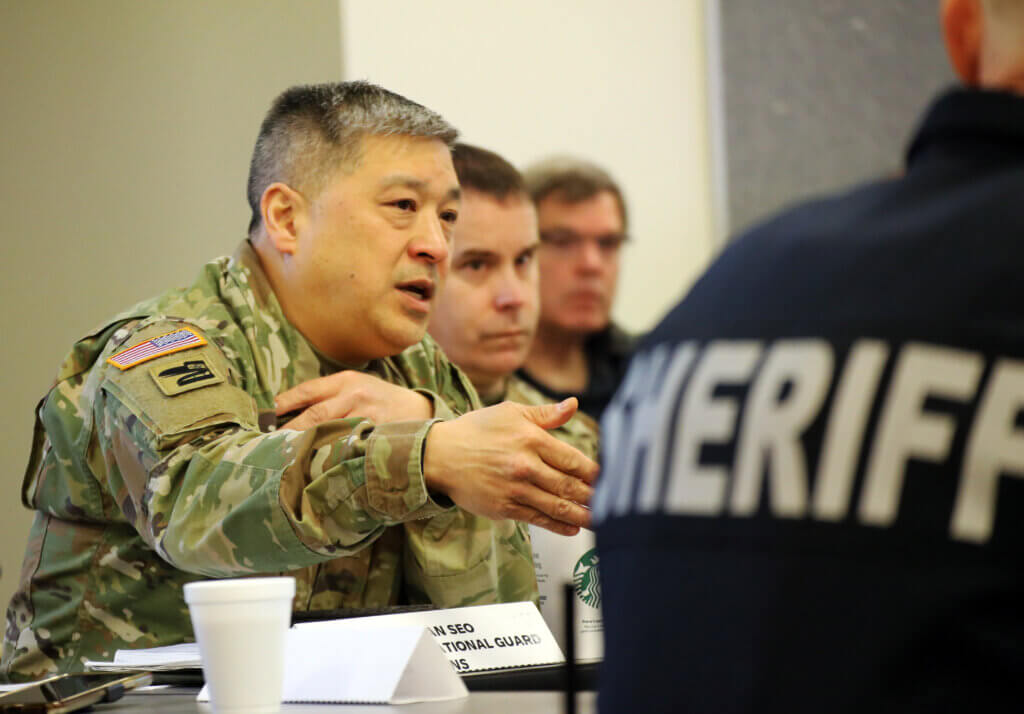In an effort to strengthen relationships with law enforcement partners, the Washington National Guard held a multi-agency table-top exercise focused on a civil unrest response on March 31, 2023 at Camp Murray, Wash.
“2020 was definitely one of the busiest times we had ever had, with the COVID-19 response and the riots following the George Floyd murder,” said 1st Sgt. Richard Little, operations non-commissioned officer at the Joint Operations Center. “It had been more than 20 years since the last civil unrest activation, so the learning curve was steep because none of us had done this mission before.”
Designed to test and refine the Civil Disturbance operational plan, the exercise brought together Washington National Guard joint staff members, law enforcement agencies, county and city emergency managers and Washington Emergency Management Division personnel who looked through the operations plan and discussed what did and didn’t work during the 2020 civil unrest in King & Pierce Counties. The discussions helped refine the collective understanding of needs, roles, triggers, and communication in the event of a similar scenario.
“We really emphasis the 72 hours. It takes 72 hours for us to deploy citizen-soldiers or airmen from the request made to boots on ground,” said Little. “We have to consider the strain on our citizen-soldiers and airmen.”
RELATED: With cyberattacks on the rise, states turn to National Guard for help
Along with the time requirements, another important part of the conversation was the process of activating members of the National Guard. Washington is what is known as a home-rule state. “Home rule” is a term used by emergency managers, which means control of resources in an emergency or disaster is at the local level. Cities or towns will make a request for assistance to the county in which it resides. If necessary, the county will forward the request to the State Emergency Operations Center where it is entered Web EOC, an online database.
“The process doesn’t start until there is a Web EOC request,” said Little. “We had already started to survey our forces to see who was trained, but we couldn’t make a move forward until an official request was made because we need to dedicate time and money.”
Col. Jim Perrin was the commander of the 81st Stryker Brigade Combat Team at the time of the 2020 riots. With the majority of Guard members deployed to Seattle for more than two weeks coming from his units, he knows the sensitivity of the situation on both sides.
“We have to make sure that we are thinking about our guardsmen and setting the expectations with them, but also with you as partners,” said Perrin. “It can be difficult, but these conversations help.”
Another aspect of the table top was to help develop a common understanding of what resources the National Guard can provide and what conditions or criteria must be met before civilian authorities will request assistance from the Guard.
“I was in law enforcement for 33 years. The way we respond to these situations has changed, it has all changed,” said Col. Michael Ake, deputy director of the joint staff.
Ake recently retired as the chief of police for the city of Tacoma, the second largest city in the state of Washington.
“We need to have these types of conversations and education about what we as leaders can do when we have these situations,” said Ake.
“When your guys came, we were in a situation where we are starting to feel over-run. That physiological impact on our officers was very important, it gave our guys a chance to catch their breath and get focused knowing they were no longer on their own,” said Chief Jeffrey Flohr, King County sheriff. “This will help us in the future know the process better.”

